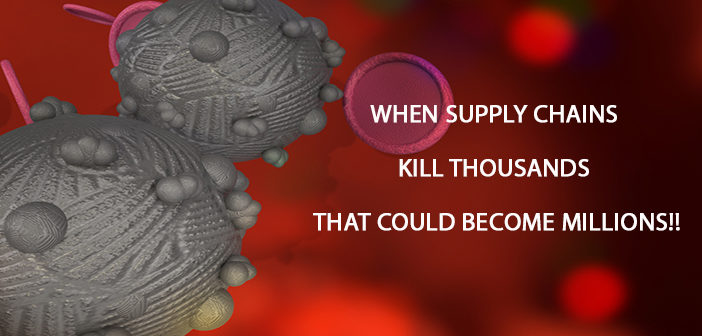By now it is obvious that the Ebola epidemic (regional) has the potential to turn into a pandemic(global). Every agency (WHO, CDC etc. etc. ) has been extremely vocal about the threat. Not only is the virus spreading but it is also mutating. New strains are already emerging and spreading and the threat of the next mutation becoming airborne cannot be ruled out. Entire suburbs are being quarantined, violence has erupted, air/ship traffic is non-existent and yet the virus spreads and is a few international passengers away from total disaster – from a few thousand tragic deaths to catastrophe. All because of the lack of a Supply Chain.
A potential solution does exist (small bio-tech) which has saved a few lives (ZMapp) but unfortunately it cannot be manufactured fast enough on a sufficient scale and then delivered to the areas where it’s needed the most. The traditional model would be for experimental trials to test out the drug, then the small bio-tech scales up somehow or the patent is acquired by a bigger player and then the drug is commercially released at a price point that would let it make its profits until the drug becomes generic and affordable. Clearly this particular Supply Chain cannot wait that long to be developed.
A different model is needed that can accelerate at warp speed the delivery of ZMapp (or other solutions) to not only save those in the region but also prevent a global catastrophe. Competitors have to collaborate. While the profit motive of bio-tech firms is what leads to advances like this, a solution must be found that might protect the profit (a financial guarantee by WHO?) and therefore allow ZMapp to release its patent. Johnson& Johnson and Bavarian Nordic are pooling their research and are therefore accelerating their trials and release of their drug. Perhaps a consortium facilitated by a global body that would allow the various companies to pool their research and be guaranteed a return is an option?
That only addresses part of the problem. Governments also have a role to play in providing a regulatory regimen that is flexible enough to deal with desperate times. While ensuring safety is critical (so we’re not compounding the problem) prudent risk management should dictate a more accelerated approach to development and trials. Not only that, but governments also need to play a very active investment role in providing capital(link).
After scaling manufacturing, ensuring distribution is still a major challenge. Transportation can only happen if the pilots/crews are willing to go to these areas. That means they need to feel confident they will have access to the drugs, if they are infected. That’s a totally different flavor of Supply Chain Risk Management than we are used to? That logic extends to the distribution channel that actually delivers the drug to the patients (doctors and nurses) and there is a huge shortage of that currently in the infected areas and the supply continues to dwindle as medical professionals are leaving in droves for fear of infection. That risk has to be mitigated for that channel immediately.
Desperate times require desperate measures and desperate ideas. Normal Supply Chain models clearly cannot work in situations like this and we as a profession must challenge ourselves to come up with a totally disruptive model that can be deployed immediately. The lives we save may be ours? We would love to hear any disruptive ideas that you may have to address this challenge.


2 Comments
Pingback: Ebola, Halloween and Supply Chain Risks - News You Can Use
Pingback: When Supply Chains Kill Thousands That Could Become Millions!! Part 2 - News You Can Use